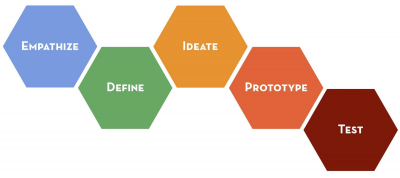There are many ways to think like a designer. When I work with clients to help them innovate, I integrate design thinking with whole-brain thinking. These practices work best with cross-functional groups to generate a diversity of ideas and perspectives. Here’s an outline of a 10-step process to use design thinking to solve problems
1. Discovery
Choose a strategic topic to focus on and learn about. Design thinking starts with an end goal, a desired future, and approaches to how you can make it happen. The topic should be one you find compelling and motivating. Research your topic for insights. What do you need to understand? What are the opportunities embedded in problems?
2. Observe
Observe users as they interact with your product, service or process. What do you see? Is there a disconnect between what someone says and what they do? Has she created shortcuts or workarounds?
3. Empathize
To create meaningful innovation you need to know your customers (internal as well as external) as real people not just users, and to care about their experiences. Ask open-ended questions such as, “What problems are they having? What does success mean to them? What do they stand to gain or lose?” Ask “why” questions to dig deeper.
4. Leverage stories to discover insights
What stories are your customers telling about their experiences? What are the hopes, fears and goals that motivate them? What insights can you draw from their problems and aspirations?
5. Frame and reframe
Shift your perspective to that of your end users or stakeholders and what they value. Framing the right problem is the only way to create the right solution. Make sense of research by seeing patterns, themes, and larger relationships between the pieces of information. Uncover customer insights to reframe problem areas into opportunities.
For example, in his book Cracking Creativity: The Secrets of Creative Genius, Michael Michalko describes how Toyota asked employees for ideas on how they could become more productive. They received few suggestions. They reframed the question to: “How can you make your job easier?” and were inundated with ideas.
6. Ideate
Now that you have some deep insights about your customers, the most powerful question you can ask to spark creativity is “What if?” Brainstorm ideas for offerings that will deliver value to your customers. Build on ideas by asking “What else?” Ideating is more than writing on Post-it notes. When I work with clients, I engage them in activities involving diverse stimuli such as drawing, painting, storytelling and improvisation to create a lively idea-friendly atmosphere.
7. Decide
Display your ideas on a wall and ask, “What wows?” Vote for the best options based on criteria such as desirability, technical feasibility and business viability. The team can then choose one to three ideas to prototype and test. This will save you from draining everyone’s energy by debating every single idea.
8. Prototype
Use prototypes to explore potential solutions. Rapid prototyping allows you to test out your ideas quickly and cheaply. Prototypes can be digital, diagrammatic or three-dimensional. The value of prototypes is in the reactions you get from users.
9. Validate your idea
Invite users to test out and respond to your prototype. How do they feel about your ideas? What feedback do they have? Their responses will inform whether you move forward or kill your idea before investing additional resources.
10. Iterate
Treat your initial ideas as stepping stones to the right solution. Design is not a linear. It is an iterative process. Use feedback to improve on your ideas and keep iterating until there is nothing more to add or subtract.


